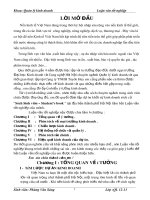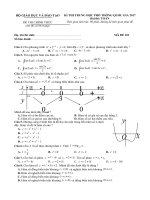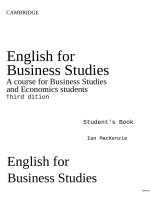Student s book full bản word
Bạn đang xem bản rút gọn của tài liệu. Xem và tải ngay bản đầy đủ của tài liệu tại đây (9.53 MB, 236 trang )
CAMBRIDGE
English for
Business Studies
A course for Business Studies
and Economics students
Third dition
Student's Book
Ian MacKenzie
English for
Business Studies
Appendix
A course for Business Studies
and Economics students
Third Edition
Student's Book
Ian MacKenzie
CAMBRIDGE
UNIVERSITY PRESS
CAMBRIDGE UNIVERSITY PRESS
Cambridge, New York, Melbourne, Madrid, Cape Town, Singapore,
Paulo, Delhi , Dubai, Tokyo
Cambridge University Press
The Edinburgh Building, Cambridge CB2 8RU, UK
www.cambridge.org
Information on this title: www.cambridge.org/9780521743419
C) Cambridge University Press 2010
This publication is in copyright. Subject to statutory exception and
to the provisions of relevant collective licensing agreements, no
reproduction of any part may take place without the written
permission of Cambridge University Press.
Appendix
First published 1997
Second Edition 2002
Third Edition 2010
Printed in the United Kingdom at the University Press, Cambridge A
catalogue recordfor this publication is availablefrom the British Library
ISBN 978-0-521-74341-9 Student's Book
ISBN 978-0-521-74342-6 Teacher's Book
ISBN 978-0-521-74343-3 Audio CD Set
Cambridge University Press has no responsibility for the persistence or
accuracy of URLs for external or third-party internet websites referred to in
this publication, and does not guarantee that any content on such websites is,
or will remain, accurate or appropriate. Information regarding prices, travel
timetables and other factual information given in this work is correct at the
time of first printing but Cambridge University Press does not guarantee the
accuracy of such information thereafter.
2
Thanks
Although only one name appears on the cover of this
book, I need to thank a great many people for their help
and hard work, beginning with Cambridge University Press
commissioning editor Chris Capper
Stephanie Ashford, Helen Bicknell, Anna Glinska, Joy Godwin,
Graham Jones and Dominique Macabies gave helpful feedback on the
previous edition The outline of this edition was worked out with
Chris Capper, Will Capel and Chris Willis.
Will Capel was the development editor, while Chris Willis also
made suggestions for the first half of the book and Joy Godwin
for the second. Alison Silver also provided ideas throughout, and
expertly and good-humouredly prepared the manuscripts for
production. Martin Crowdy's expertise was tapped for the units on
accounting and finance. All of the editors will find some of
their ideas in the book—though I probably scoffed at them at
Appendix
first before managing to convince myself they'd been my ideas all
along!
Will Capel set up most of the UK interviews, and Pete Kyle
expertly recorded them, with an extraordinarily large microphone
on the end of a pole. One other recording was produced by James
Richardson. Pete Kyle also produced and edited the CDs. My thanks
go to all the interviewees, who graciously gave us their time and
shared their expertise with us: John Antonakis, Olga Babakina,
Richard Barker, Martin Beniston, Charles Cotton, Carlo de
Stefanis Denis Frucot, Janine George, Melissa Glass, Alan
Goodfellow, Anna-Kim Hyun-Seung, Lakshmi
Jaya, Michael Kitson, Teresa La Thangue, Alison Maitland,
Tony Ramos, Chris Smart, Krishna Srinivasan, Saktiandi
Supaat and Rory Taylor. Thanks also go to the writers whose
texts I have used, and the cartoonists whose work (mostly
from The New Yorker) brightens up the pages.
Thanks are also due to Chris Doggett for dealing with
permissions, Hilary Luckcock for finding the photographs,
Linda Matthews at Cambridge University Press for arranging
the production schedule, Wild Apple Design who can and do
turn sows' ears into silk purses (as the saying doesn't
go), and Kevin Doherty for porof-raeding. Prospective
thanks go out to all of Cambridge University Press's sales
and marketing people.
I've dedicated previous books to my children, but this time I
have to revert to the equally traditional apology-to-partner
paragraph: sorry, Kirsten, for the surliness that went with many
months of writing a book while also working full-time and taking
on too many other commitments. (Oddly, she doesn't believe my
assurances that this will never happen again!)
Ian MacKenzie
September 2009
3
Contents
Thanks
3
Appendix
Introduction to the learner
Map of the book
6
7
Management
Economics
1 Management
2 Work and motivation
3 Company structure
10
15
21
4 Managing across cultures
26
5 Recruitment
6 Women in business
30
38
Production
7 The different sectors of the 42
economy
8 Production
47
51
9 Logistics
10 Quality
56
Marketing
1 1 Products
12 Marketing
13 Advertising
60
64
69
22 Government and taxation
23 The business cycle
24 Corporate social
responsibility
25 Efficiency and
employment
26 Exchange rates
27 International trade
28 Economics and ecology
109
1 14
119
124
128
132
136
Role cards
142
Audio scripts
Appendix 1: How to give
a good
presentation
Appendix
2:
Writing
emails,
letters
and
reports
Acknowledgements
156
181
185
190
Finance
14 Banking
15 Venture capital
16 Bonds
17 Stocks and shares
18 Derivatives
19 Accounting and financial
statements
20 Market structure and
competition
21 Takeovers
73
77
81
86
91
95
100
105
Contents
5
Introduction to the learner
English for Business Studies is a reading, listening, speaking
and writing course for learners with at least an upperintermediate level of English (Common European Framework for
Languages level B2) who need to understand and express the key
concepts of business and economics. It covers the most important
areas
of
management,
production,
marketing,
finance
and
macroeconomics.
Appendix
This course aims to:
present you with the language and concepts of
business and economics found in books journals,
newspapers and magazines, and on websites
develop your comprehension of business and economics texts
develop your listening skills in the fields of business and
economics
provide you with opportunities to express
business concepts both verbally and in writing, by
reformulating them in your own words while summarizing,
analysing, criticizing and discussing ideas
Most of the units contain four components.
An informative reading text giving an overview of a
particular
topic,
introducing
key
concepts,
and
including a lot of relevant technical vocabulary, plus
a variety of comprehension and vocabulary exercises and
discussion activities. Some of the texts come from
newspapers and books about business or economics.
Listening activities, mostly based on interviews with
business people, economists and other experts. The
listening
material
includes
British,
American,
Australian and South African voices, but also speakers
from several European and Asian countries. Listening to
non-native speakers of English is important as much of
the English you will hear in your professional life
will be spoken by people who don't have English as
their first language.
1
2
Speaking activities including discussions, case studies, role
plays and presentations. 4 Writing activities including
summaries, emails, memos and reports.
3
If you are using this book in a class with a teacher, it will
give you lots of opportunities to discuss ideas and issues with
other learners (in pairs or small groups), and to develop and
defend your own point of view.
If you are using this course on your own, you will still be able
to do the reading and listening exercises. You will find the
answers to the exercises in the English for Business Studies
Teacher's Book.
I hope you enjoy using this book.
Appendix
6
Introduction to the learner
Map of the book
Reading
1
Management
2 Work and
motivation
3 Company
structure
4 Managing
across
cultures
5 Recruitmen
t
6 Women in
business
7 The
differen
t
sectors
of
the
economy
Listening
MBA
students:
What makes a
good
manager?
Theory X and
MBA students:
Theory
Managers and
Y; 'Satisfiers' motivation
and
'motivators'
Wikinomics
MBA students:
and
the
Big and small
future
of
companies
companies,
Company
structure
Managing across MBA students:
cultures
Managers,
authority, and
cultural
diversity
Filling a
John
vacancy; Job
Antonakis
applications
(manageme
nt
professor
):
Job
interview
s
You're
Alison
fired! (The
Maitland
Guardian)
(writer
and
journalist):
Women
in
business — a
strategic
issue
Another cup of The business
tea
news
(radio)
(David Lodge:
Nice Work);
Manufacturing
and services
What is
management?
Speaking
Writing
Case study.
Summary;
Selecting a
Chief
Operating
Officer
Case study: A Summary;
car
manufacturer
Presentation: Notes for a
Presenting a presentatio
company
n
Role play:
Welcoming
American
colleagues
Autobiograp
hical text
Role play: A Curriculum
job interview vitae
or
resume
Role play: Do Memo or
we need more email
women
managers?
Discussion:
Business
Your place in news item
the economy
Appendix
8 Production Capacity
and Alan
Goodfellow
inventory;
(IT
'The Dell
director):
Theory of
Purchasing
Conflict
and low-cost
Prevention'
manufacturing
(Thomas
Role play:
Choosing
suppliers
Friedman: The
World
Is Flat)
9 Logistics
Pull
and
push
strategies;
Supplychain
ing (Thomas
Friedman: The
World
Is
Flat); Supply
chain
work
flow
Alan
Goodfellow:
Inventory,
Kanban
and
MRP;
Leica's
supply
chain
Case study:
Summary;
Risk analysis report
Map of the book 7
Unit
1 Quality
0
Reading
Listening
Speaking
Total Quality
Management
Role play: A Email
hotel
chain
in trouble
1
1
Products
Products and
brands
1
2
Marketing
The product
life cycle;
Marketing
is
everything
Denis Frucot
(hotel
manager):
Customer care
and
quality
in a hotel
Melissa Glass
(juice
bar
director):
Smoothies
and a juice
bar
Melissa
Glass:
Promoting a
juice bar
Case
study:
Researchin
g
a
product
concept
Case
study:
Promoting
a
new
product
Writing
Report
Description
of
distributio
n channels
(Regis McKenna:
Harvard Business
Review)
1 Advertisin Advertising
and viral
3 g
Radio
commercials
Scripting a
radio
commercial
1
4
Tony Ramos
(HSBC):
Role play:
Microfinance
Banking
marketing
Banks and
financial
institutions;
The subprime
crisis and the
credit crunch
Commercial
banking;
Anna-Kim
HyunSeung
Summaries;
radio
commercial
Minutes of
a meeting
Appendix
(expert on
business
ethics):
Microfinance
1
5
Venture
capital
A business
plan
1
6
Bonds
Bonds; How to
profit from
bonds (The
Guardian and
The
Independent)
1
7
Stocks and
shares
Stocks
and
shares; Hedge
funds (Geraint
Anderson:
Cityboy)
Spread-betting
(Times
1
8
Derivative
s
1
9
Accountin
g and
financial
statement
s
8
Online)
Google Inc.'s
financial
statements
Chris
Smart
(venture
capitalist):
Investing in
start-ups
Teresa
La
Thangue
(Financial
Services
Authority):
Bonds
and
subprime
mortgages
Role
play: Summary
Investing in
start-ups
Case study:
Investing in
funds
Report
A
financial Role
play:
news
report Investing
a
(radio)
client's
money
Teresa
La
Thangue:
Hedge
funds
and
structured
products
Richard
Barker
(senior
lecturer
in
accounting):
Valuing
assets
Role play:
Financial
instruments
Training
memo
Role
play:
Presenting
a company's
results
Map of the book
Appendix
Role cards
Audio scripts
Appendix 1: How to give a good
presentation
Unit
Reading
20 Market
structure
and
competitio
n
Market
structure
21 Takeovers
Takeovers,
mergers and
buyouts
22 Government
and
taxation
The role of
government
(Milton
and
Rose
Friedman:
Free to Choose)
2
3
The
business
cycle
24 Corporate
social
responsibi
lity
What causes
the
business
cycle?
•
Keynesianis
m
and
monetarism
Profits and
social
responsibility
25 Efficiency
and
employment
Reorganizing
Anna-Kim
the
postal HyunSeung:
service
Efficiency,
the
number
of
Listening
employees,
training and
Charles
productivity
Cotton26 Exchange
Exchange rates Michael
(IT
rates
Kitson:
consultan
Currency
t):
flows
and
Companies
the
Tobin
and
Tax;
clusters
Developing
Rory Taylor
Africa
(Competition
27
Internatio
Education
Michael
Commission):
nal
trade
and
Kitson:
Free
Market
protection
trade
and
investigations
(Ha-Joon
exceptions
Michael
Chang,
Kitson
economist)
(senior
28 Economics
The
Martin
lecturer and
in
economics
Beniston
internation
ecology
of climate
(professor of
al
change
climate
macroeconom
(Christian
science):
ics):
Gollier,
Climate
Government
economist)
policy
interventio
Appendix 2: Writing emails, letters
n
and reports 142
Michael
156
Kitson:
181
Consumption
and 185 the
Map of the book
business
cycle;
Keynesianis
m
Anna-Kim
Aims
HyunSeung:
Q
Socially
responsible
C
o
investment;
n
Stakeholder
s
i
groups
d
Management
e
r
10
Unit Management
w
h
a
t
t
h
e
f
u
n
c
t
i
o
n
s
o
f
m
a
n
a
g
e
m
e
n
t
a
r
e
Q
D
i
s
c
u
s
s
w
h
a
t
m
a
k
e
s
a
g
o
o
d
m
a
n
a
g
e
r
Lead-in
To
wh
at
ex
te
nt
is
ef
fe
ct
iv
e
ma
na
ge
me
nt
so
me
th
in
g
yo
u
ar
e
bo
rn
wi
th
,
as
op
po
se
d
to
a
se
t
of
11
s
k
i
l
l
s
rs
do
yo
u
ad
mi
re
fo
r
th
ei
r
ma
na
ge
ri
al
sk
il
ls
?
Wh
at
ar
e
th
es
e
sk
il
ls
?
• Do
ma
na
ge
rs
ha
ve
a
go
od
re
pu
ta
ti
on
t
h
a
t
c
a
n
b
e
t
a
u
g
h
t
?
hi
c
h
b
u
s
i
n
e
s
s
l
e
a
d
e
12
Unit Management
i
n
y
o
u
r
c
o
u
n
t
r
y
?
O
r
a
r
e
t
h
e
y
m
a
d
e
f
u
n
o
f
i
n
j
o
k
es
,
ca
rt
oo
ns
an
d
te
le
vi
si
on
se
ri
es
?
If
so
,
wh
y
do
yo
u
th
in
k
th
is
is
?
"Hey, this is brilliant! Where do you get my
ideas?"
• Whic
h
of
th
e
fi
ve
fa
mo
us
ma
na
ge
rs
13
b
e
l
o
w
te
re
st
in
g
an
d
im
pr
es
si
ve
?
d
o
y
o
u
f
i
n
d
A
k
i
o
M
o
r
i
t
a
c
o
f
o
u
n
d
e
d
a
c
o
m
p
a
n
y
i
n
T
o
t
h
e
©
T
h
e
N
e
w
Y
o
r
k
e
r
m
o
s
t
i
n
14
Unit Management
k
y
o
i
n
1
9
4
6
,
a
n
d
l
a
t
e
r
c
h
a
n
g
e
d
i
t
s
n
a
m
e
t
o
S
o
n
y
.
H
e
m
o
v
e
d
t
o
t
h
e
U
S
,
w
h
e
r
e
h
e
h
a
d
t
h
e
o
r
i
g
i
n
a
l
i
d
e
a
s
f
o
r
15
t
h
e
W
a
l
k
m
a
n
a
n
d
t
h
e
v
i
d
e
o
c
a
s
s
e
t
t
e
r
e
c
o
r
d
e
r
.
S
16
Unit Management
o
n
y
a
c
q
u
i
r
e
d
m
u
s
i
c
a
n
d
f
i
l
m
c
o
m
p
a
n
i
e
s
,
a
n
d
d
e
v
e
l
o
p
e
d
v
i
d
e
o
g
a
m
e
s
.
W
h
i
l
e
J
a
c
k
W
e
l
c
h
w
a
s
C
h
i
e
f
E
x
e
c
u
t
i
v
e
O
f
f
i
c
e
r
(
C
E
O
)
o
f
G
e
n
e
r
a
l
E
l
e
c
t
r
i
c
i
n
t
h
e
1
9
8
0
s
a
n
d
1
9
17
S
t
e
v
e
J
o
b
s
w
a
s
f
i
r
s
t
t
h
e
c
o
f
o
u
n
d
e
r
a
n
d
l
a
t
e
r
t
18
Unit Management
h
e
C
E
O
o
f
A
p
p
l
e
.
H
e
w
a
s
f
i
r
e
d
f
r
o
m
h
i
s
o
w
n
c
o
m
p
a
n
y
(
!
)
i
n
1
9
8
5
,
a
n
d
c
o
f
o
u
n
d
e
d
P
i
x
a
r
A
n
i
m
a
t
i
o
n
S
t
u
d
i
o
s
,
b
u
t
r
e
j
o
i
n
e
d
A
p
p
l
e
i
n
1
9
9
7
,
a
n
d
h
e
l
19
p
e
d
d
e
v
e
l
o
p
t
h
e
i
P
o
d
a
n
d
t
h
e
i
P
h
o
n
e
.
1
20
Unit Management
Management
In 1998, Meg Whitman joined a start-up
company called eBay in Silicon Valley as
President and CEO. She resigned ten years
later, when it was a hugely successful
business, planning to run for Governor of
California.
Carlos Ghosn, born in Brazil,
but a French and Lebanese
citizen, became the CEO of
the Nissan car company in
2001 . In 2005, he also
became CEO of Renault. At
Nissan, he converted huge
debts into huge profits.
Unit
21
(from
Discussion:
Russia)
What makes a good manager?
What do you think are the three most important
characteristics of a good manager? Are there any
qualities or characteristics you would add to the
ones mentioned by the MBA students?
Management
1
Unit
22
Reading: What is management?
Read the text summarizing the different
functions of management. Which of the
qualities
mentioned
in
the
Listening
exercise do you think are particularly
necessary for the five
tasks described by
Peter Drucker?
Management is important.
The success or failure of
companies, public sector
institutions
and
services,
not-forprofit
organizations,
sports
teams, and so on, often
depends on the quality of
their managers. But what
do managers do? One wellknown classification of
the tasks of a manager
comes from Peter Drucker.
Drucker was an American
business
professor
and
consultant who is often
called things like 'The
Father
of
Modern
Management'.
Drucker suggested that
the work of a manager can
be
divided
tasks:
into
planning
five
(setting
objectives),
organizing,
integrating
(motivating
and
communicating),
measuring performance, and
23
Unit Management
their
organization
can
achieve or accomplish them.
This
involves
developing
strategies,
plans
and
precise
tactics,
and
allocating
resources
of
people
and
money.
•
Secondly, managers organize.
They analyse and classify
the
activities
of
the
organization
and
the
relations among them. They
divide
the
work
into
manageable
activities
and
then into individual tasks.
They
select
people
to
perform these tasks.
Thirdly, managers practise the
social skills of motivation and
communication. They also have to
communicate objectives to the
people responsible for attaining
them. They have to make the
people
Writing
who are responsible for
performing individual tasks
form teams. They make
decisions about pay and
promotion. As well as
organizing and supervising
the work of their
subordinates, they have to
work with people in other
areas and functions.
Fourthly, managers have to measure
the performance of their staff,
to see whether the objectives or
targets set for the organization
as
a
whole
and
for
each
Lastly,
managers
people
—
develop
both
their
subordinates and themselves.
A
company's
also
have
top
to
managers
consider
the
future, and modify or change
the organization's obiectives
when necessary, and introduce
the
innovations
allow
the
continue.
have
Top
suppliers,
bankers,
will
to
managers
also
to manage
relations
that
business
with
a business's
customers,
distributors,
investors,
neighbouring
communities,
public
authorities,
and
so
on, as well as deal with any
crisis that arises.
Although the tasks of a
manager can be analysed and
classified in this fashion,
management is not entirely
scientific.
There
are
management skills that have
to be learnt, hut management
is also a human skill. Some
people are good at it, and
others are not. Some people
will
be
unable
to
put
management
techniques
into
practice. Others will have
lots of technique, but few
good
ideas.
Excellent
managers are quite rare.
Write a brief summary of each of the five
tasks listed by Drucker.
1
24
Unit Management
Management
Vocabulary
1 Match
up the following words and definitions.
1 consultant
2 crisis
a plan for achieving success
3 innovation
4 objective
a person with a less important position in an
organization
(noun)
5
6
7
8
promotion
a new idea or method
a person who provides expert advice to a
company
a situation of danger or difficulty
public sector
something you plan to do or achieve
strategy
subordinate
the section of the economy under government
control
when someone is raised to a higher or more
important position
2 The
text contains a number of common verb—noun combinations. Use
the word combinations in the box to complete the sentences
below.
allocate resources deal with crises make decisions perform tasks measure
performance set objectives supervise subordinates
1
After an organization has it has to make sure
that it achieves them.
2
Managers have to find the best way to
the human, physical and capital
all
available
to them.
3
Some people better on their own while others work
better in teams.
4
Managers
the work of their
and try
to develop their abilities.
5
Managers
the
of
their
staff
to
see whether they are reaching their targets.
6
Top managers have to be prepared to if they
occur and then have to
quick
Case study: Selecting a Chief Operating Officer
Three companies are looking for a senior manager — a
Chief Operating Officer who will be responsible for
Unit
25









